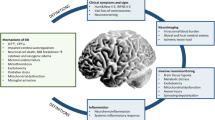Abstract
Acute central nervous system injuries include head injury, spinal cord injury, focal and global cerebral ischemia and subarachnoid hemorrhage (SAH). Our paper focuses on brain injury and on SAH. Trauma is the first cause of death below the age of 45 in many countries all over the world (1); head injury contributes in the vast majority of cases. An average of 200 patients per 100.000 population per year are admitted to the hospital following a head injury. About 20 per 100.000 population per year are the deaths related to the brain injury (1). Many cases among the survivors present neurological sequelae leading to severe disability. SAH is less frequent (11 cases per 100.000 inhabitants per year); mortahty and morbidity in this disease are mainly related to the occurrence of vasospasm (40% to 60% of patients) (2). Both in brain injury and in SAH patients there is primary brain damage due to mechanical factors in head injuries and to hemorrhagic stroke in SAH. This primary damage is followed by secondary damage due to biochemical processes in the tissue surrounding the primary injury. Secondary ischemia, which is present both following brain injury and during vasospasm, leads to loss or reduction of blood flow and oxygen supply. With the improvement in our knowledge concerning this biochemically induced damage, a new set of drugs has been tested in animal models. A few of these drugs reached a phase II — III clinical trial both in SAH and in brain injured patients.
Access this chapter
Tax calculation will be finalised at checkout
Purchases are for personal use only
Preview
Unable to display preview. Download preview PDF.
Similar content being viewed by others
References
Kraus JF (1991) Epidemiologie features of injuries to the central nervous system. In: Anderson W, Schoenberg D (eds) Neuroepidemiology: a tribute to Bruce Schoenberg. CRC, Boca Raton
Wier B, Rothenberg CH, Grace M, Davis F (1975) Relative prognostic significance of vasospasm following subarachnoid hemorrhage. Can J Neurol Sci 2:109–114
Gotoh O, Mohamed AA, McCullogh J et al (1986) Nimodipine and the hemodynamic and histopathological consequences of middle cerebral artery occlusion in the rat. J Cerebr Blood Flow Metab 6:321–331
Tettenborn D, Dycka J (1990) Prevention and treatment of delayed ischemic dysfunction in aneurysmal subarachnoid hemorrhage. Stroke 21 [Suppl IV]:85–89
Pickard JD, Murray GD, Illingworth L et al (1989) Effect of oral nimodipine on cerebral infarction and outcome after subarachnoid hemorrhage. Br Med J 298:636–642
Ohman J, Heiskanen O (1988) Effect of nimodipine on outcome of patients after aneurysmal subarachnoid hemorrhage and surgery. J Neurosurg 6:683–686
Zuccarello M (1989) Protective effects of 21 aminosteroid on the blood brain barrier following subarachnoid hemorrhage in the rat. Stroke 20:367–371
Steinke DE, Wier BKA, Findlay JM et al (1989) A trial of 21 aminosteroid U74006F in a primate model of chronic cerebral vasospasm. Neurosurgery 24:179–186
Haley Clarke E, Kassel NF, Wayne M et al (1995) Phase II trial of tirilazad in aneurysmal subarachnoid hemorrhage. J Neurosurg 82:786–790
Kassel NF (1995) Unpublished data presented at the World Congress of Neurosurgery. Acapulco, Mexico, 1993
Teasdale G on behalf of the cooperative study (1992) Randomized trial of nimodipine in severe head injury: Hit 1. J Neurotrauma 9 [Suppl 2]:S545-S550
Teasdale G The European Study Group on Nimodipine in Severe Head Injury (1994) A multicenter trial of the efficacy of nimodipine on outcome after severe head injury. J Neurosurg 80:797–804
Smith DH, Gennarelli TA, Mcintosh T (1995) The potendal of 21 aminosteroids as neuroprotective therapies in CNS injury. CNS Drugs 3(3):159–164
Muizelar JP, Marmarou A, Young HF et al (1993) Improving the outcome of severe head injury with oxygen radical scavenger polyethylene glycol conjugate superoxide dismutase: a phase II trial. J Neurosurg 80:797–804
Muizelar JP (1995) Unpublished data presented at the First World Congress on Brain Injury, Copenhagen
Sanada, Nakamura T, Nishimura MC et al (1993) Effect of U74006F on neurologic functions and brain oedema after fluid percussion injury in rats. J Neurotrauma 10:65–71
Mcintosh TK, Thomas M, Smith DH et al 0992) The novel 21 aminosteroid U74006F attenuates cerebral oedema and improves survival after brain injury in the rat. J Neurotrauma 9:33–40
Hall ED, Yonkers PA, McCall JM et al (1988) Effects of the 21 aminosteroid U74006F on experimental head injury in mice. J Neurosurg 68:456–461
Bullock R, Fujisawa H (1992) The role of glutamate antagonists for treatment of CNS injury. J Neurotrauma 9 [Suppl 2]:S443-S461
Editor information
Editors and Affiliations
Rights and permissions
Copyright information
© 1996 Springer-Verlag Italia, Milano
About this chapter
Cite this chapter
Servadei, F., Giuliani, G., Nasi, M.T., Arista, A. (1996). Clinical Trials in Acute CNS Injuries. In: Gullo, A. (eds) Anaesthesia, Pain, Intensive Care and Emergency Medicine — A.P.I.C.E.. Springer, Milano. https://doi.org/10.1007/978-88-470-2203-4_54
Download citation
DOI: https://doi.org/10.1007/978-88-470-2203-4_54
Publisher Name: Springer, Milano
Print ISBN: 978-3-540-75014-7
Online ISBN: 978-88-470-2203-4
eBook Packages: Springer Book Archive




